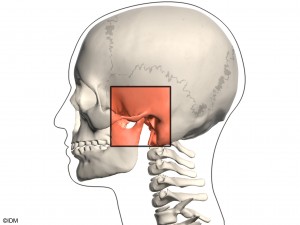TMD: Shedding Light on the Disorder of the Jaw

Some of the basics regarding TMD

The Temporomandibular or (TM) joint is the main joint within the jaw. There are two jaws that work together in conjunction, one in front of each ear. The muscles that are in control of these joints are what governs the movement of the jaw to go up and down, side to side, and forward and back.
Every time you need to open your mouth, the rounded upper ends of the mandible on each side of the jaw glide along the joint socket right at the skull’s base.
When the mouth is closed, they slide back to their original position, and a soft tissue keeps this motion working smoothly by absorbing the shock to the joint.
What occurs during a Temporoamandibular Disorder?

During these disorders, pain in the jaw joint, limitation in the movement of the jaw, and other things that are happening within the body such as arthritis may affect the ability to do important daily functions.
The abilities to chew, swallow, and breathe can be affected, and start to become a large problem with the health of the entire mouth and jaw region.
Scientists have discovered that most patients who suffer from TMD also experience pain in numerous other locations of the body.
This pain can be a result of conditions such as chronic fatigue syndrome, bad headaches, endometriosis, fibromyalgia, irritable bowel syndrome, low back pain, and sleep disorders. Much like the dangerous disease of diabetes, TMD is very complex, and there are environmental, behavioral, and gene-related factors that are all at hand.
Who Exactly is affected by TMD?
Approximately 13% of the population in the United States are affected by TMD, and it is interesting to note that for those seeking treatment, a high majority are women that are in their childbearing years. Around nine women for every one man have the types of symptoms that are very severe, such as serious limitations in jaw movements, and very chronic pain.
What Causes TMD?
This is one of those conditions that in an overall sense, much is really not known about the cause and root of the problem. Some of the issues that many doctors claim to be known causes are as follows:
• Serious autoimmune diseases
• Previous injuries to the jaw
• Dental procedures one has had in the past
• Having a breathing tube inserted before surgery
• Different types of arthritis
• Grinding and clenching of the teeth
• Being under a high amount of stress
Some studies have also shown that there is a particular type of gene in some that increases sensitivity to pain, and it has been found among TMD patients more than others in the population. It has also been shown that doing things such as chewing gum and playing the violin may also make one susceptible to TMD due to the ways you have to position the head, and put strain on the jaw to hold the instrument.
What are some of the symptoms of TMD?
Even though some patients actually report having no pain, the vast majority of those that do claim that it is usually a very dull ache. The joints of the jaw and areas nearest to it are the ones that patients usually complain about pain. Here are some of the kinds of pains that those who suffer from this complain of:
• Neck and shoulder pain
• Pain in the jaw muscles
• Very chronic headaches
• stiffness in the jaw muscle
• Jaw begins to lock up
• Ringing in the ears, pressure, and pain
• Popping of the jaw when opening and closing your mouth
• Teeth feeling off when you bite and chew
• Extreme Dizziness
• Noticeable vision problems
What are some potential treatments for TMD?
Sometimes, those with TMD have relatively mild symptoms which do improve after any given length of time. There are things that can be done like making sure you eat softer foods, applying heating pads to the jaw, and trying to avoid doing things like vigorous singing and gum chewing that can aggravate the condition more. Here are some treatments that have been proven to be effective, and a bit of specific details on each one.
For many sufferers, the use of Pain Medication like ibuprofen can provide temporary relief from the discomfort you are going through. If it seems that they are not cutting it, your doctor can prescribe medications that may be stronger such as muscle relaxers, and even antidepressants that will help ease the symptoms and trigger points of the condition.
Once you are taking medication, it’s important to follow up very closely with the doctor, as side effects and other issues could lead to different combinations or doses.
The specialist you see may also provide a stabilization splint or bite guard, which is composed of acrylic resin, and is placed over the teeth. This fix is usually only used for short periods of time, and won’t produce a permanent change in the bite. One thing to consider is that some patients have claimed that wearing one of these actually encourages clenching and grinding, and may not be the best solution.
There are some other treatments that are fairly irreversible, but many have disputed them as working well and helpful. Many are skeptical on these other treatments, and not enough research has been done yet to deem them all of the way successful.
Steroids can help with many conditions, but the exact outcome with TMJ is still to be debated: Here are some other treatments that some patients opt for:
• Orthodontic treatment that changes the bite
• Crown and bridge work
• Adjustment by grinding down teeth
• Botox and hyaluronan injections
• Injections of steroids
What about the option of implants?
Some implant treatments for TMJ are controversial, and many of the most seasoned professionals claim that this option is only good for a last resort. There are patients who have had multiple jaw surgeries may have used it to improve function, but many studies show that it is not that effective for reducing pain.
If a patient has been under duress for years, it may be a good choice, but is still known as a procedure for those who are on the desperate end of the spectrum to feel better.
Relate Posts to Read:
Stiff Jaw: Causes and Cures for this Painful Problem
Medically Fact-Checked & Written by Our Dental Editorial Team
You can read more about our editorial guidelines by clicking this link and learn more about the Emergency Dentists USA editorial team here.




